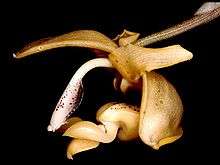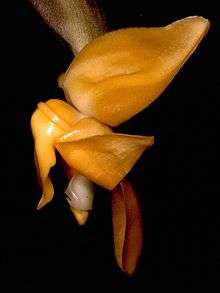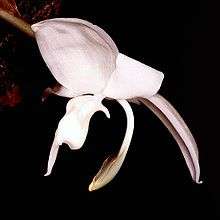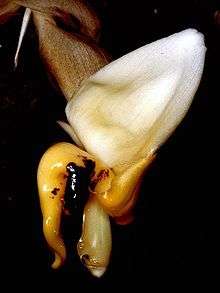Stanhopea
| Stanhopea | |
|---|---|
 | |
| Stanhopea insignis | |
| Scientific classification | |
| Kingdom: | Plantae |
| (unranked): | Angiosperms |
| (unranked): | Monocots |
| Order: | Asparagales |
| Family: | Orchidaceae |
| Subfamily: | Epidendroideae |
| Tribe: | Maxillarieae |
| Subtribe: | Stanhopeinae |
| Genus: | Stanhopea J. Frost ex Hook. 1829 |
| Type species | |
| Stanhopea insignis J.Frost ex Hook. | |
| Synonyms[1] | |
| |
Stanhopea (J. Frost ex Hook. 1829) is a genus of the orchid family (Orchidaceae) from Central and South America.[2] The abbreviation used in horticultural trade is Stan. The genus is named for the 4th Earl of Stanhope (Philip Henry Stanhope) (1781-1855), president of the Medico-Botanical Society of London (1829-1837). It comprises 55 species and 5 natural hybrids. These epiphytic, but occasionally terrestrial orchids can be found in damp forests from Mexico to Trinidad to NW Argentina.[1][3][4][5] Their ovate pseudobulbs carry from the top one long, plicate, elliptic leaf.
Stanhopea is noted for its complex and usually fragrant flowers that are generally spectacular and short-lived. Their pendant inflorescences are noted for flowering out of the bottom of the containers in which they grow, lending themselves to culture in baskets that have enough open space for the infloresence push through. They are sometimes called upside-down orchids.
Primitive Stanhopeas[6]
Most Stanhopea flowers flash prominent, elegant horns on the epichile. The exception are the species; S. annulata, S. avicula, S. cirrhata, S. ecornuta and S. pulla. A second group have short or truncated horns, they include the species; S. candida, S. grandiflora, S. reichenbachiana, S. tricornis and the natural hybrid S. x herrenhusana. The structure of the labellum of this group is in general, not as complex as other members of the genus.
With most Stanhopea flowers lasting three days or less, the flowers must attract pollinators very quickly. These chemical attractants are generated in the hypochile, attracting the male euglossine bees to the flower. These male euglossine bees are known to be important pollinators of Stanhopea flowers, collecting fragrances at these flowers over their lifetime and storing them in their hind tibia. Bees in the Euglossini tribe, including Eulaema meriana, are known to pollinate these flowers supposedly because the orchids can deceptively mimic the form of a female and her sex pheromone.[7] When the bee touches down on the flower, a great effort is made to collect chemical scent - he eventually slides on the waxy surface of the hypochile, gliding down on the slippery lip to exit the flower. The long column is touched in the process, resulting in the bee taking up pollinia at the very tip of the column. When the bee slides down another flower, the pollinia are deposited on the sticky surface of the stigma.
The majority of species are robust plants that grow readily in cultivation. For relatives of Stanhopea see Stanhopeinae and the closely related sister subtribe Coeliopsidinae.
Species



- S. anfracta (SE. Ecuador to Bolivia).
- S. annulata (S. Colombia to Ecuador).
- S. avicula (Panama).
- S. bueraremensis (E. Brazil).
- S. candida (S. Trop. America).
- S. cirrhata (C. America)
- S. confusa G. Gerlach & Beeche (2004) (Costa Rica)
- S. connata (Ecuador to Peru).
- S. costaricensis (C. America)
- S. deltoidea (Peru to Bolivia).
- S. dodsoniana (NC. & S. Mexico).
- S. ecornuta (C. America).
- S. embreei (Ecuador).
- S. florida (= S. nigripes; Ecuador to Peru).
- S. frymirei (Ecuador).
- S. gibbosa (= S. carchiensis, = S. impressa; Colombia & W. Ecuador).
- S. grandiflora (Trinidad to S. Trop. America).
- S. graveolens (Mexico to C. America, Brazil to NW. Argentina).
- S. greeri (Peru).
- S. haseloffiana (N. Peru).
- S. hernandezii (C. & SW. Mexico).
- S. insignis (SE. & S. Brazil)
- S. intermedia (SW. Mexico).
- S. jenischiana (W. South America).
- S. lietzei (E. & S. Brazil).
- S. maculosa (W. Mexico).
- S. maduroi (Panama)
- S. manriquei Jenny & Nauray (2004) (Peru)
- S. martiana (SW. Mexico).
- S. napoensis (Ecuador)
- S. naurayi Jenny (2005) (Peru)
- S. nicaraguensis (E. Brazil).
- S. novogaliciana (Mexico - Nayarit, Jalisco).
- S. oculata (Mexico to Colombia, SE. Brazil)
- S. ospinae (Colombia).
- S. panamensis (Panama).
- S. peruviana (Peru).
- S. platyceras (Colombia)
- S. posadae (Jenny et Braem 2004) (Colombia).
- S. pozoi (Ecuador to Peru).
- S. pseudoradiosa (SW. Mexico).
- S. pulla (Costa Rica to Colombia).
- S. quadricornis (Venezuela).
- S. radiosa (W. Mexico).
- S. reichenbachiana (Colombia).
- S. ruckeri (= S. inodora; Mexico to C. America).
- S. saccata (Mexico -Chiapas to C. America).
- S. shuttleworthii (Colombia).
- S. stevensonii (Colombia).
- S. tigrina (Mexico).
- S. tolimensis (Colombia).
- S. tricornis (W. South America).
- S. wardii (C. America to Venezuela).
- S. warszewicziana (Costa Rica).
- S. xytriophora (Bolivia to N. Argentina).
Natural hybrids
- Stanhopea × fowlieana (Stanhopea costaricensis × Stanhopea ecornuta) (Costa Rica)
- Stanhopea × herrenhusana (Stanhopea reichenbachiana × Stanhopea tricornis) (Colombia)
- Stanhopea × horichiana (Stanhopea ecornuta × Stanhopea wardii) (Costa Rica)
- Stanhopea × lewisae (Stanhopea ecornuta × Stanhopea inodora) (Guatemala)
- Stanhopea × thienii (Stanhopea annulata × Stanhopea impressa) (Ecuador)
Intergeneric hybrids
- × Aciopea (Acineta × Stanhopea). Aciopea Guillermo Gaviria (Acineta erythroxantha × Stanhopea wardii) was registered Nov-Dec 2004 by Guillermo Gaviria-Correa (Colombia).
- × Aciopea is abbreviated Aip..
- × Cirrhopea (Cirrhaea × Stanhopea)
- × Coryhopea (Coryanthes × Stanhopea)
- × Stangora (Gongora × Stanhopea)
- × Stanhocycnis (Polycycnis × Stanhopea)
Gallery
Species
 Stanhopea anfracta
Stanhopea anfracta Stanhopea annulata
Stanhopea annulata Stanhopea candida
Stanhopea candida Stanhopea cirrhata
Stanhopea cirrhata Stanhopea connata
Stanhopea connata_pl._8830_(1920).jpg) Stanhopea costaricensis
Stanhopea costaricensis Stanhopea ecornuta
Stanhopea ecornuta Stanhopea embreei
Stanhopea embreei Stanhopea grandiflora
Stanhopea grandiflora
Natural Hybrids
 Stanhopea × horichiana
Stanhopea × horichiana
References
- 1 2 Kew World Checklist of Selected Plant Families
- ↑ Pridgeon, A.M., Cribb, P.J., Chase, M.C. & Rasmussen, F.N. (2009). Epidendroideae (Part two). Genera Orchidacearum 5: 1-585. Oxford University Press, New York, Oxford.
- ↑ Forzza, R. C. 2010. Lista de espécies Flora do Brasil http://floradobrasil.jbrj.gov.br/2010. Jardim Botânico do Rio de Janeiro, Rio de Janeiro
- ↑ McLeish, I., N. R. Pearce & B. R. Adams. 1995. Native Orchids of Belize. 1–278.
- ↑ Idárraga-Piedrahita, A., R. D. C. Ortiz, R. Callejas Posada & M. Merello. (eds.) 2011. Flora de Antioquia: Catálogo de las Plantas Vasculares 2: 9–939. Universidad de Antioquia, Medellín.
- ↑ http://autrevie.com/Stanhopea/Stanhopea_Primitives.html
- ↑ Schiestl, F. P.; Roubik, D. W. (2003-01-01). "Odor Compound Detection in Male Euglossine Bees". Journal of Chemical Ecology. 29 (1): 253–257. doi:10.1023/A:1021932131526. ISSN 0098-0331.
- Gerlach, G. & Beeche, J. 2004: Stanhopeinae Mesoamericanae III (Orchidaceae). Reestablecimiento de Stanhopea ruckeri y una especie nueva: Stanhopea confusa. Lankesteriana 4(3): 213-222.
- Gerlach, G. 2010: Stanhopeinae Mesoamericanae V: El aroma floral de las Stanhopeas de Mexico. Lankesteriana 9(3): 431-442.
- Rudolf Jenny (December 1993) "The Genus Stanhopea," in: Orchids 62(12):1270-1277
- Rudolf Jenny (December 2003) "The Genus Stanhopea. Part 1: S. anfracta to S. napoensis," in: Caesiana no. 21, Supplement. 200 color photos, 160 p.
- Jenny, R. (2004) "The genus Stanhopea: 2nd part, S. nigripes to S. xytriophora" Caesiana no. 22: 146-291.
- Gerlach, G. (2004). "Die Subtribus Stanhopeinae. 6. Stanhopea". J. Orchideenfreund. 11 (1): 53–76. (in German)
External links
-
 Media related to Stanhopea at Wikimedia Commons
Media related to Stanhopea at Wikimedia Commons -
 Data related to Stanhopea at Wikispecies
Data related to Stanhopea at Wikispecies - Photo collections of Stanhopea from Botanical Garden Munich.
- The Stanhopea Pages website by Nina Rach
- The Stanhopea website by Dick Hartley